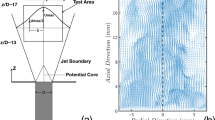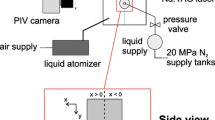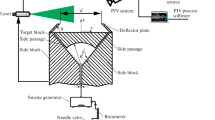Abstract
Pulsed laser Mie scattering and laser Doppler velocimetry (LDV), both conditioned on the origin of the seed particles, have been successively performed in turbulent jets with variable density. In the early stages of the jet developments, significant differences are measured between the ensemble average LDV data obtained by jet seeding and those obtained by seeding the ambient air. Careful analysis of the marker statistics shows that this difference is a quantitative measure of the turbulent mixing. The good agreement with gradient–diffusion modelling suggests the validity of a general diffusion equation where the velocities involved are expressed in terms of ensemble conditional Favre averages. This operator accounts for all events (including intermittent ones) and for variations in the density of the marked fluid whose velocity is still specified by the binary origin of the marker.






Similar content being viewed by others
Abbreviations
- D L :
-
laminar diffusivity, m2/s
- D T :
-
turbulent diffusivity, m2/s
- d :
-
diameter of the jet nozzle, m
- F r :
-
Froude number
- J :
-
diffusion vector, m/s
- k :
-
global sensitivity of the detection system for one particle (signal level)
- N P :
-
number of seed particles in the probe volume
- N P,i :
-
number of seed particles in sample i
- N P (i) :
-
value of N P in channel i
- N B :
-
number of Doppler bursts
- \( {\dot{N}_{{\rm{B}}} } \) :
-
count rate of bursts, s−1
- N v :
-
number of validated Doppler bursts
- \( {\dot{N}_{{\rm{V}}} } \) :
-
count rate of validated bursts, s−1
- N id :
-
number of ideal particles
- N id*:
-
number of marked ideal particles
- P*:
-
probability that an ideal particle be marked by a seed particle
- P(ρz):
-
probability density function for ρz, m3/kg
- \( {P_{{(N_{{\rm{P}}} = k)}} } \) :
-
probability to have k seed particles in the probe volume
- \( {P_{{(N_{{\rm{P}}} = k\left| {\rho z)} \right.}} } \) :
-
probability of having k seed particle conditioned on a given value of ρz
- r :
-
radial coordinate, m
- R ρ :
-
=ρ (1)/ρ (2), density ratio
- S1 :
-
local signal level with jet seeding
- S 1 (1) :
-
reference signal level in pure stream 1 with jet seeding
- s 1 :
-
= S1/S1 (1), normalized signal
- v c :
-
volumic capacity of the probe volume, m3
- V :
-
velocity vector, m/s
- V x :
-
axial velocity component, m/s
- V r :
-
radial velocity component, m/s
- V P :
-
particulate velocity vector, m/s
- V Pj :
-
velocity vector of particle j, m/s
- V Pij :
-
velocity vector of the jth particle in sample i, m/s
- V i :
-
velocity vector of the marked flow for realization i, m/s
- V 1,i :
-
velocity vector of the flow such it is marked in realization i by particles issuing only from stream 1, m/s
- x :
-
axial coordinate, m
- Y i :
-
local mass fraction of species i
- Z :
-
mixture fraction:local mass fraction of jet fluid
- Z i :
-
mixture fraction for realization i
- ρ :
-
local density, kg/m3
- ρ i :
-
local density for realization i, kg/m3
- ρ (1) :
-
density in stream 1 (density of the jet fluid), kg/m3
- τ 1 :
-
time of flight of jet seed particles to reach the probe volume, s
- τ B :
-
duration of a Doppler burst, s
- <A>:
-
ensemble average of A
- Ā:
-
time average of A
- \( {\overline{\overline A} } \) :
-
Favre average, \( {\overline{\overline A} = {{\overline{{\rho A}} } \over {\overline{\rho } }}} \), (\( {\overline{\overline A} \equiv \tilde{A}} \)) the present notation is only due to printing problems
- A″:
-
Favre fluctuation, \( {{A}'' = A - \overline{\overline A} } \)
References
Becker HA (1977) Mixing, concentration fluctuations, and marker nephelometry. In: Launder BE (ed) Studies in convection, vol 1. Academic Press, London, pp 45–139
Becker HA, Hottel HC, Williams GC (1967) On the light-scatter technique for the study of turbulence and mixing. J Fluid Mech 30:259–284
Bilger RW (1976) Turbulent jet diffusion flames. Prog Energy Combust Sci 1:87–109
Bilger RW (1979) Turbulent jet diffusion flames. In:Chigier NA (ed) Energy and combustion science, Stud Ed 1. Pergamon Press, Oxford, pp 109–131
Chassaing P (1980) Melange turbulent de gaz inertes dans un jet tube libre. Thèse de Doctorat, Toulouse, France.
Chen CJ, Rodi W (1980) Vertical turbulent buoyant jets. A review of experimental data, Pergamon Press, New York
Dahm WJ, Dimotakis PE (1987) Measurement of entrainment and mixing in turbulent jets. AIAA J 25:1216–1223
Dibble RW, Hartmann V, Schefer RW, Kollmann W (1987) Conditional sampling of velocity and scalars in turbulent flames using simultaneous LDV-Raman scattering. Exp Fluids 5:103–113
Ebrahimi I, Kleine R (1977) The nozzle fluid concentration fluctuation field in round turbulent free jets and jet diffusion flames. Proc Combust Inst 16:1711–1723
Favre A (1969) Statistical equations of turbulent gases. In Lavrentiev MA (ed) Problems of hydrodynamics and continuum mechanics. SIAM, Philadelphia, pp 231–266
Hinze JO (1975) Turbulence. McGraw-Hill, New York
Labacci K, Trinité M, Stepowski D, Cabot G (1988) Conditional LDV in a turbulent diffusion flame. In: Durao DFG (ed) Proceedings of the Fourth International Symposium on Applications of Laser Anemometry to Fluid Mechanics, Session 9. Instituto Superior Tecnico, Lisbon, Portugal, p 5
Long MB, Chu BT, Chang RK (1881) Instantaneous two-dimentional gas concentration measurements by light scattering. AIAA J 19:1151–1157
Pope S (2000) Turbulent flows. Cambridge University Press, Cambridge, UK
Pratt DT (1976) Mixing and chemical reaction in continuous combustion. Prog Energy Combust Sci 1:73–86
Sautet JC, Stepowski D (1994) Single shot laser Mie scattering measurements of the scalar profiles in the near field of turbulent jets with variable densities. Exp Fluids 16:353–367
Sautet JC, Stepowski D (1995) Dynamic behaviour of variable-density, turbulent jets in their near development fields. Phys Fluids 7:2796–2806
Sautet JC, Stepowski D (1998) Evolution of the effective nozzle diameter in the buoyancy free development of turbulent jets with variable density. Exp Fluids 25:280–282
Shaughnessy EJ, Morton JB (1977) Laser light-scattering measurements of particle concentration in a turbulent jet. J Fluid Mech 80:129–148
Starner SH (1983) Joint measurements of radial velocity and scalars in a turbulent diffusion flame. Combust Sci Technol 30:145–169
Stepowski D, Cabot G (1988) Laser Mie scattering measurement of mean mixture fraction density and temperature by conditional seeding in a turbulent diffusion flame. Proc Combust Inst 22:619–625
Stepowski D, Sautet JC (1998) Near fields of jets with variable density. Recent Res Dev Phys Fluids 1:25–44
Struminskiy VV (1987) Kinetic theory of turbulent flow. Fluid Mech Sov Res 16:17–42
Tennekes H, Lumley JL (1972) A first course in turbulence. The MIT Press, Cambridge, Mass.
Vauclair S (1993) Eléments de physique statistique. Inter Edition, Paris
Williams FA (1985) Combustion theory. Benjamin Cummings, Menlo Park, Calif.
Author information
Authors and Affiliations
Corresponding author
Rights and permissions
About this article
Cite this article
Stepowski, D., Sautet, J.C. Measurement of the turbulent diffusivity in the near field of variable density jets using conditional velocimetry. Exp Fluids 35, 397–407 (2003). https://doi.org/10.1007/s00348-003-0662-5
Received:
Accepted:
Published:
Issue Date:
DOI: https://doi.org/10.1007/s00348-003-0662-5




